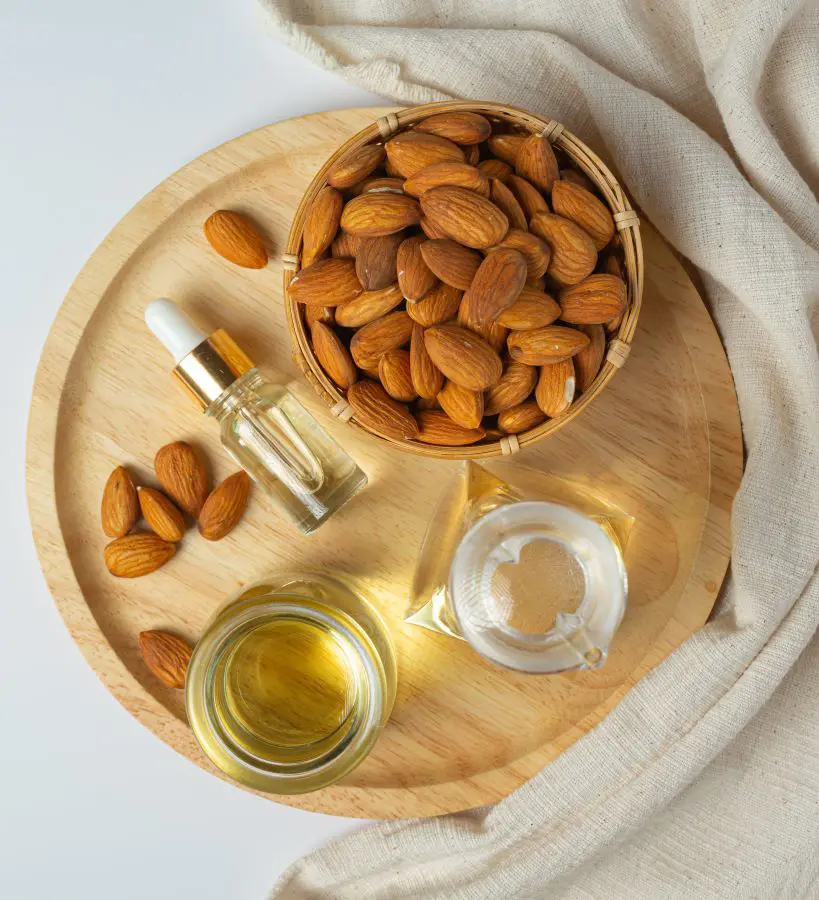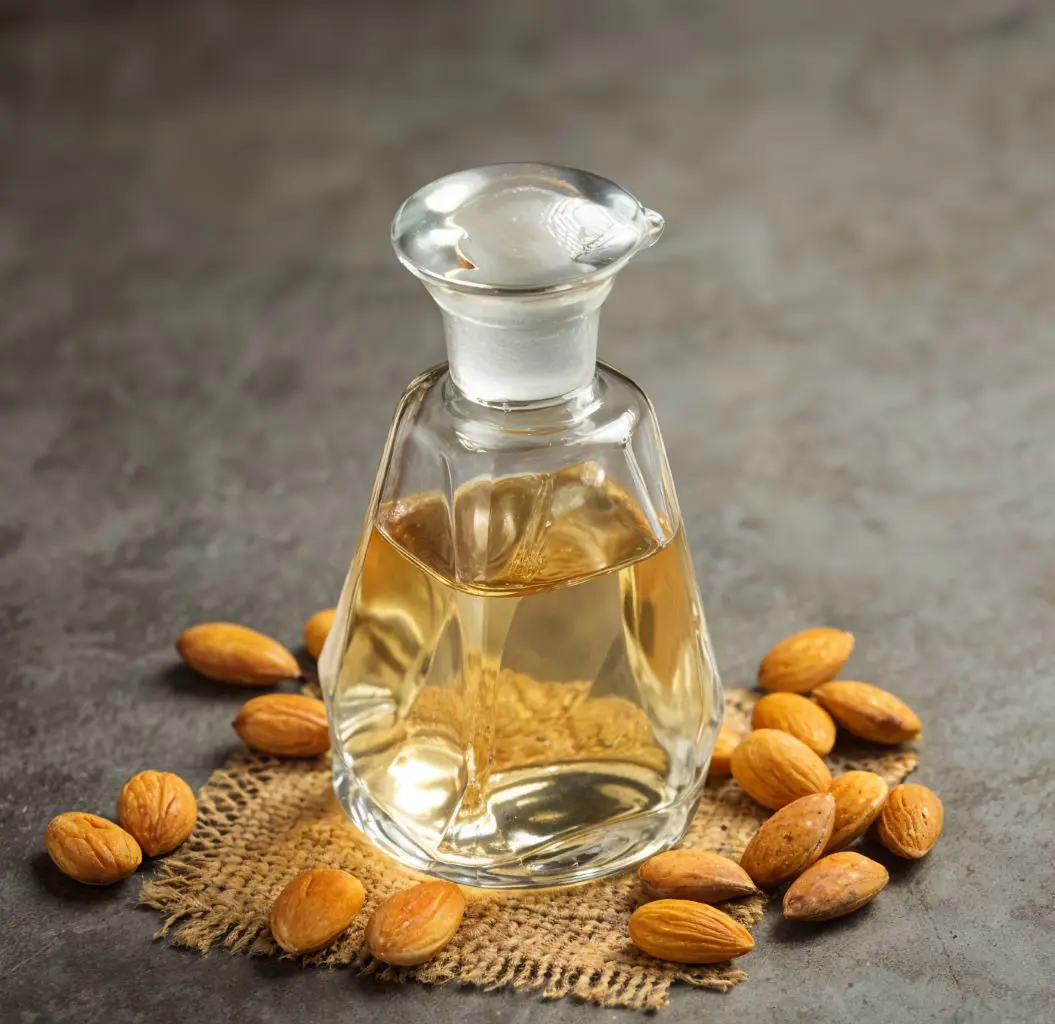Almond oil is one of the popular oils due to its rich nutrients. People have been using almond oil throughout history in various sectors, like skincare, healthcare, and even cooking. Given its versatility and beneficial nature, it's no surprise that almond oil is one of the most recommended and most used oils in the haircare department.
In this blog, we will discuss the importance of almond oil for hair. We will also learn how to apply it, choose the right almond oil, its extraction process, and whether we can make almond oil at home.
Benefits of Almond Oil for Hair
Almond oil has several benefits for hair care due to its large amount of nutrients. It contains elements like vitamins E, A, and D, essential fatty acids like oleic and linoleic acids, and minerals such as magnesium, calcium, and zinc.
Overall, almond oil is beneficial in almost every department of haircare. Sweet almond oil is particularly useful for hair as it helps to condition and soften hair, add shine, reduce frizz, prevent split ends, and improve overall hair health. It also nourishes the scalp, promoting a healthy environment for hair growth.
So, here are the benefits of almond hair that make your haircare regimen a breeze-
1. Helps in Hair Growth
People have long used almond oil for hair growth. But how, you may wonder? It enhances blood circulation to the scalp, which results in improved nutrient delivery to hair follicles. As a result of using these oils, you get nourished and strong hair, but you also witness reduced breakage and healthier growth.
Additionally, almond oil contains moisturizing properties, which help to prevent dryness and flakiness on the scalp, creating a better environment for hair growth. Regular use of almond oil helps to make our hair healthier and stronger, which ultimately contributes to hair growth.
2. Conditions Hair
Wondering what is almond oil good for? Almond oil is good for several reasons, one of them being that great hair conditioner. Yes, almond oil conditions hair by deeply moisturizing each strand, which helps to make hair softer and more manageable.
The presence of rich fatty acids and vitamins in almond oil nourishes the hair and scalp, improving overall health and reducing dryness. To improve our hair conditions, we should use almond oil regularly.
3. Reduces Frizz

Frizzy hair is a condition where the hair is not in synchronization and looks messy. In this case, we can use almond oil to reduce frizz. This oil by smoothing the hair cuticle prevents the hair from becoming rough and uneven.
In fact, the moisturizing properties of an almond oil provide essential hydration, making hair more manageable. Furthermore, sweet almond oil for hair forms a protective layer to help lock in moisture and shield against humidity.
4. Prevents Split Ends
Split-end hairs can happen to anyone at any time and occurs at the end of the hair. Almond oil helps prevent split ends by nourishing and strengthening the hair shaft with the help of rich elements contained in the oil. Also, the moisturizing properties of almond oil help to maintain hair elasticity and reduce brittleness, which can lead to split ends.
The almond oil saves the hair from various external factors and possible damage. Continuous use of almond oil in regular intervals efficiently helps avoid split ends in hair.
5. Promotes Shine
Shine and softness are essential for hair as they enhance its overall appearance, making it look healthy and vibrant. Regular and effective use of almond oil makes our hair more shiny and soft.
Almond oil promotes shine by smoothing the hair cuticle, which reflects light more evenly and enhances the hair's natural luster. Its rich fatty acids and nutrients nourish the hair, making it smoother and less prone to dullness. The oil also adds a natural, healthy sheen without making the hair greasy or weighed down.
6. Nourishes the Scalp
Almond oil nourishes the scalp by delivering essential nutrients such as vitamins E, A, and D, and fatty acids that promote overall scalp health. Its moisturizing properties help to alleviate dryness and flakiness, creating a balanced and hydrated environment.
The oil also improves blood circulation to the scalp, which supports healthy hair growth and strengthens hair follicles. We can use almond oil on a regular basis for effective nourishment of our scalp.
7. Reduces Dandruff

Dandruff is one of the most common hair problems in the world. Almond oil helps to reduce dandruff due to its fatty acids, which moisturize the scalp, vitamin E, which soothes inflammation, vitamin A, which supports skin repair, and antioxidants, which protect the scalp and promote overall health.
The oil also helps to loosen and remove dead skin cells, which can help clear existing dandruff. We can use almond oil in the most effective and efficient way, at regular interval to get the maximum output, which helps to reduce dandruff.
8. Improves Hair Texture
Almond oil enhances hair texture by providing deep moisture and nourishment, which makes hair softer and smoother. It strengthens and repairs the hair with its fatty acids and vitamins, reducing brittleness and roughness.
By smoothing the hair cuticle, it promotes a more uniform and polished look. Consistent use of almond oil leads to improved texture and a healthier, shinier appearance.
9. Strengthens Hair
Strong hair is the desire of every person. Strong hair not only makes our hair strong, it also controls hair fall, and provides healthier hair. Almond oil strengthens hair by delivering essential nutrients like vitamins E and B, which support hair health and resilience. Its fatty acids penetrate the hair shaft, reducing breakage and enhancing overall strength.
The oil also helps to smooth and seal the hair cuticle, protecting it from damage and preventing split ends. People use almond oil regularly to gain the maximum benefits of it and make their hair stronger.

10. Protects from Damage
Hair Damage is one of the most critical hair problems in the modern world. To avoid hair damage we can use almond oil. Almond oil protects our hair from any kind of damage due to the presence of various elements in the oil portion.
The oil also helps to smooth and seal the hair cuticle, protecting it from harmful external elements and preventing split ends. Regular use of almond oil fortifies hair, making the chance of getting hair damage lower.
How to Apply Almond Oil on Hair
Applying almond oil to your hair varies based on individual needs and preferences. It is important to understand the correct use of almond oil to maximize its benefits, leading to stronger, healthier, and more vibrant hair.
The simple and most effective guidelines for applying almond oil to your hair are listed below.
-
Apply to Scalp
First, we apply the almond oil to the hair. When applying almond oil to the scalp, it's important to consider various factors such as the type of almond oil being used, our scalp and hair type, application duration, and frequency of use.
-
Distribute through Hair
After applying almond oil to the scalp, we distribute such applied oil throughout our hair by using our fingers gently. We massage our hair thoroughly to ensure every part is treated, giving special attention to areas with dryness and damage.
-
Comb Through
When we finished distributing the almond oil throughout the hair, we used a comb to detangle our hair. Using a comb also helps in making evenly distribution of almond oil in our hair and scalp.

-
Leave in
After finishing all the steps mentioned above, leave the oil in your hair for at least 30 minutes. For a deep conditioning treatment, you can leave it on for a few hours or overnight.
-
Rinse and Shampoo
After applying almond oil, rinse it out of your hair using warm water to help dissolve the oil. Then, use a shampoo suitable according to your hair requirement to clean your hair. Before finishing, rinse thoroughly and use shampoo to ensure that your hair is completely clean and free of any residual oil.
-
Condition
Although the almond oil itself will have provided deep conditioning, you can use conditioner as per your requirement. Conditioner hydrates, smooths, and protects hair, making it softer, shinier, and easier to manage.
Choosing an Almond Oil

There are two main types of almond oil. They are
Sweet Almond Oil
Sweet almond oil is a mild, nutty scent oil that is widely used in skincare, haircare, massage oils, and even cooking due to its safety and nutritional content. It is the most used and preferred almond oil, as it is safe for external and internal use, making it versatile for various applications.
It is extracted from the seeds of the sweet almond tree, and is rich in vitamins E and A, fatty acids, and proteins, making it excellent for moisturizing and nourishing the skin and hair.
Bitter Almond Oil
Bitter almond oil is a strong, bitter scent oil primarily used for medicinal purposes, and in aromatherapy. It can be potentially toxic if not processed correctly and is generally not recommended for internal use or skincare and haircare.
Bitter almond oil is extracted from the seeds of the bitter almond tree and contains amygdalin, which can be poisonous. Bitter almond oil should be used with caution and is typically reserved for specialized uses in aromatherapy or medicine.
Recommendation
For haircare, sweet almond oil is the best choice over bitter almond oil.
The sweet almond oil is rich in vitamins E and A, fatty acids, and proteins, making it an excellent choice for haircare. The use of sweet almond oil is good for both hair and hair growth. Bitter almond oil can't be used in haircare applications due to the presence of some elements that are not favorable for hair.
Process of Extracting Almond Oil
To get the almond oil, we need to extract almond oil from the seeds of an almond tree. The extracting process of almond oil starts with harvesting almonds and ends with packaging almond oil.
The detailed process of extracting almond oil is listed below:
- Harvesting Almonds

The timing for harvesting almonds should be perfect, otherwise almond nuts will not be as nutritious as they should be. We harvest almonds when they are ripe and collect them for the further extraction process.
- Cleaning and Drying
The harvested almonds are now cleaned to get rid of any dirt or impurities. The almonds are cleaned with the help of cold water. If the quantity of almonds is large, they are generally washed in a commercial washer.
After washing the harvested almonds, the cleaned almonds are dried to reduce moisture content. This helps prevent mold growth and ensures a higher yield of oil. Drying almonds can be done using a dehydrator or by air drying in a clean, well-ventilated area.
- Shelling
In this process, the outer shell of the almond is removed to obtain the edible seed, known as the almond kernel. The shelling of almonds helps to increase the efficiency of extraction and the quality of oil.
- Extraction or Pressing
After removing the shell of almonds, such almonds are now processed for the pressing or extraction process. Different methods can be used to extract or press almonds to obtain almond oil.
The different methods of extraction of almonds are:
Cold Pressing:
In cold pressing, Almonds are first crushed and then pressed using a hydraulic press or a screw press without additional heat. It’s considered to produce the highest quality oil, since it doesn't involve high temperatures.
Expeller Pressing:
It involves a similar process to cold pressing but but involves a mechanical expeller that applies high pressure to the almonds. This method is efficient for large quantities and produces a good quality oil, though it might have slightly less flavor compared to cold-pressed oil.
Solvent Extraction:
In the solvent extraction process, almonds are first ground into a meal and then treated with a solvent to dissolve the oil. The solvent is then evaporated, leaving behind the oil. Solvent extraction is often used for commercial purposes, as it yields a higher proportion of oil as compared to other methods.
Heat Pressing:
Heat pressing methods involve heating almonds before being pressed to increase oil yield during the pressing process. Heat pressing increases the efficiency of oil extraction, but the high temperatures can affect the flavor and nutritional content of the oil.
- Filtering and Refining
The extracted almond oil is now filtered to remove any impurities or solid particles from the oil. The filtering is done to obtain pure and clear almond oil.
The refining process in extracting almond oil is optional, and many people prefer unrefined almond oil. Refining is often done for commercial purposes to achieve a specific smell or color.
- Packaging
In the final stage of the extraction process of almond oil, the almond oil is packed in a bottle in a suitable place to protect it from light and air. Such packaged oil can be used whenever and wherever required, as needed.
Can We Make Almond Oil at Home?
Yes, we can make almond oil at home. Though making almond oil at home requires more patience and effort, it can be a rewarding process once the oil is extracted. We can make almond oil at home either by using a blender or using a pressed oil.
Making Almond Oil in a Blender
To make almond oil in a blender, we require 2 cups of unroasted almonds, 1-2 tsp. olive oil, and a blender. The steps involved in making almond oil in the blender are:
Step 1:
First, place the almonds into the clean blender. The almonds should be dry and fresh.

Step 2:
Blend them at low speed first, so that the almonds are blended slowly and carefully. Blending them at high speed at first will make the blending process more difficult.
Step 3:
Pause the blender to clean the build-up several times so that it ensures even blending. Pausing the blender in some intervals helps to avoid overheating, and also protects the equipment.
Step 4:
Blend the almonds at a higher speed. Blending almonds at high speed makes faster processing, efficient oil release, and improves consistency.
Step 5:
Add the olive oil when the almonds are thoroughly blended. Adding olive oil helps to loosen the mixture, making it smoother and easier to spread, and it enhances the stability of the blender.
Step 6:
After finishing blending the almonds, store them in a container and keep them in the fridge for about 2 weeks. This helps to preserve the freshness of almond oil and fully separate almonds from the almond solids.
Step 7:
The collected almonds should be drained to extract as much oil as possible. It can be done either using a sieve or container or by tipping the container.
Step 8:
In the final stage, the collected almond oil is stored. Such collected almond oil can be used at any time as per necessity.

Making Almond Oil using an Oil Press
• The almond oil can be extracted at home with the help of an oil press. The steps involved in extracting almond oil using an oil press are:
• First, place the almonds on the top of an oil press. This will put almonds in the proper position for pressing, which helps maximize oil yield and efficiency.
• After placing almonds on top of an oil press, start turning the crank on the oil press. This step is crucial for efficiently extracting high-quality almond oil using a traditional oil press, as it helps to control the process during extraction and prevent oil buildup.
• Now, simply place a cup below the almonds and wait for the oil to be released into the cup. After some time, cranking the press will be easier, and oil can be collected effectively.
• In the final stage, the collected almond oil is stored as it can be used at any time if necessary.










